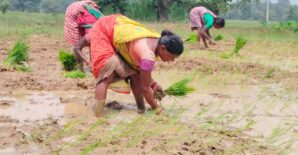First of two blog posts on a recent study on a social learning game intervention in the state of Madhya Pradesh, India. Read the second post here.
India’s water systems are under increasing pressure from widespread over-exploitation by agriculture, which consumes 80% of the country’s fresh water. Dams, reservoirs, and other water harvesting structures constructed in rural communities can provide supplementary irrigation, especially during increasingly frequent dry spells, and reduce flood risks. In addition, these structures provide water for livestock and domestic purposes and support managed fisheries.
Recognizing their value, the Indian government and development partners have invested heavily in constructing and rehabilitating dams across the country. Yet poor maintenance threatens their long-term functionality. Government agencies often lack the personnel on the ground and financial resources needed for ongoing maintenance, management, and operations. In this context, cooperation among local actors is a vital alternative in fulfilling these tasks or complementing formal mechanisms. Yet fostering such cooperation is challenging where local institutions are weak or absent, and where social trust is low.
One promising, low-cost solution for these problems is gaining traction: Social learning interventions in the form of facilitated games that can help communities navigate the coordination challenges of reservoir management. These games create a safe, interactive environment where community members can simulate real-world water dilemmas. By simulating water use dilemmas, evidence shows that such games can help in encouraging communication, fostering cooperation, and empowering communities to develop context-appropriate management rules.
In a study published in PNAS Nexus, we examined the potential impact of a game intervention on rural dam and reservoir management. We tested one such exercise in 56 randomly selected villages in the state of Madhya Pradesh, comparing their reservoir maintenance post-intervention with that of 28 control villages that did not participate in the game. In March-June 2017, 14 participants per treated village participated in the intervention.
In each round of the game, each player was given a fixed endowment and decided individually how much to invest in dam maintenance (influencing water availability) and which crops to plant (influencing water distribution). They had to balance short-term profit against maximizing long-term benefits of the group. After playing 10 rounds, villagers joined a structured discussion to link the game’s lessons to local realities and identify ways to improve water governance, e.g., by formulating rules for regular maintenance activities.
The results of the intervention were compelling: Two years after the intervention, leaders from participating villages reported a 20% higher likelihood that their villages had maintained their dams.
For policymakers, however, simply knowing that an intervention works is not enough; its benefits must also outweigh the costs incurred. This is where cost-benefit analysis that quantifies costs and benefits in monetary terms becomes essential. As part of this study, we performed a back-of-the-envelope cost-benefit analysis weighing the per-village costs of the intervention vs. the benefits of improved maintenance.
Regional economic assessments for the Madhya Pradesh State Planning Commission indicate that, on average, a fully functional dam in Madhya Pradesh generates around $1,900 per year in income from agriculture and fishing. Annual maintenance costs are roughly $450, while losses from neglect can range from $820-$1,500 per year due to declining performance.
Delivering the intervention costs about $73 per village (including facilitator time, training, logistics, materials, and opportunity costs of villagers). A conservative cost-benefit analysis, assuming benefits decline slightly over five years and discounting at 10% annually, shows the payback period is less than one year. In one year, the return on investment is around 28%; over five years, it is around 733%. Thus, the analysis suggests that this game intervention achieves substantial benefits with low costs.
India’s water crisis exemplifies a complex common-pool resource challenge, where conflicting individual and collective interests combine with weak governance to jeopardize sustainability. Experiential learning games offer a promising pathway to overcome these barriers. Because our different water games are simple to facilitate and inexpensive to deliver, they have already been integrated into NGO and government programs, reaching over 4,800 communities across India from 2019-2023.
Ultimately, water is a shared asset. Its bounty will endure only through collective stewardship—and innovative, participatory approaches like experiential learning games provide a vital tool to achieve this.
Thomas Falk is a Research Fellow with IFPRI’s Natural Resource and Resilience Unit; Björn Vollan is the head and Ivo Steimanis is a Research Fellow at the Working Group on Sustainable Use of Natural Resources at Marburg University, Germany; Lara Bartels is a Senior Research Fellow at the Max Planck Institute for Research on Collective Goods, Vishwambhar Duche is Senior Scientific Officer a the International Crops Research Institute for the Semi-Arid Tropics (ICRISAT); Ruth Meinzen-Dick a Research Fellow Emeritus with IFPRI’s Director General’s Office. Opinions are the authors’.
The work has been supported by the German Federal Ministry for Economic Cooperation and Development (BMZ), the CGIAR Policy Innovations Science Program, and the Co-Impact Philanthropic Funds.
Reference:
Steimanis, Ivo; Falk, Thomas; Bartels, Lara; Duche, Vishwambhar; and Vollan, Björn. 2025. The role of women in learning games and water management outcomes. PNAS Nexus 4(8): pgaf243. https://doi.org/10.1093/pnasnexus/pgaf243
This blog was first posted here.



